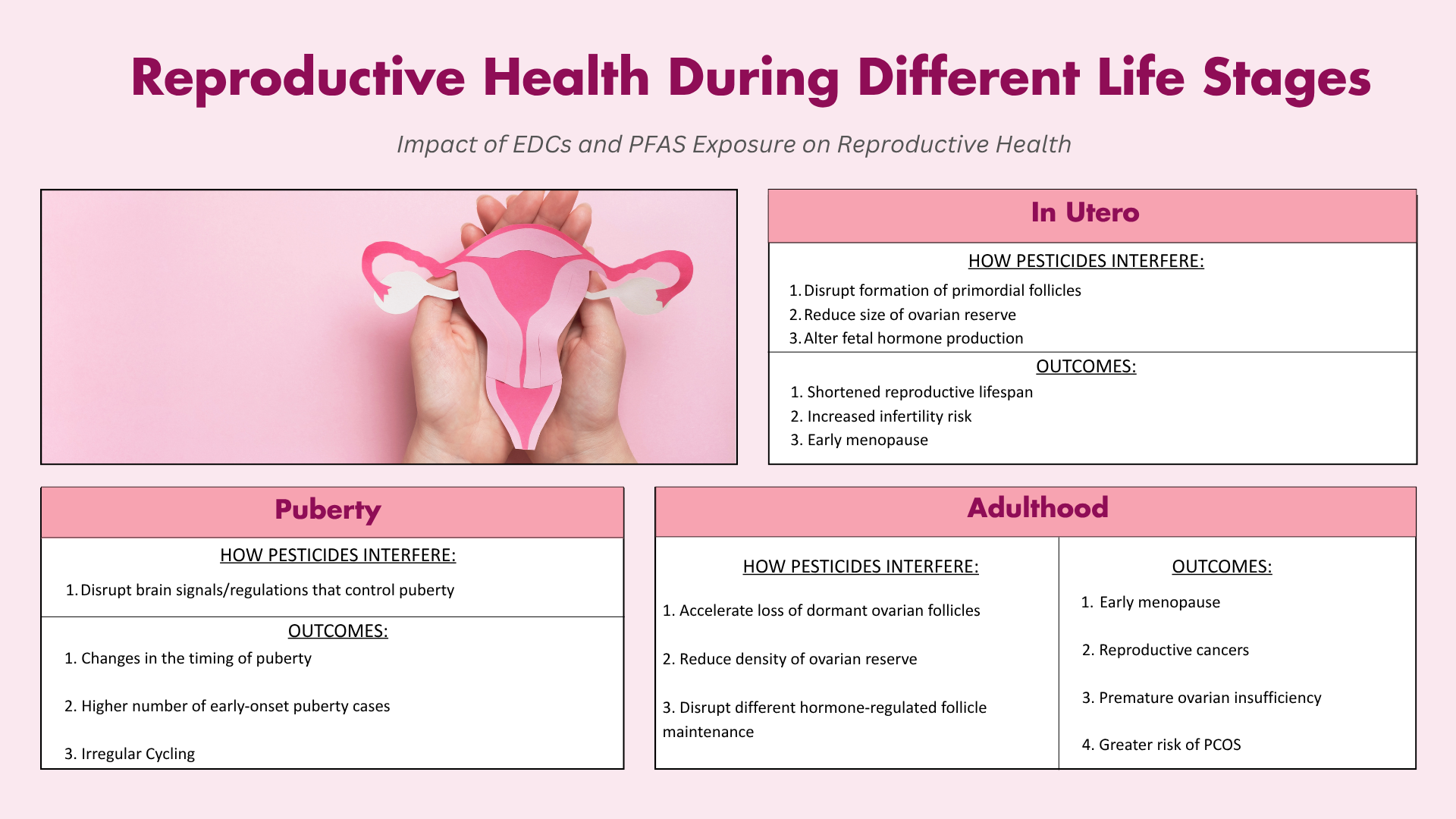22
Jul
Womb to Menopause: Endocrine Disrupting Chemicals’ Effects on Reproductive Health

(Beyond Pesticides, July 22, 2025) A study published in May by Nature Reviews Endocrinology warns that endocrine-disrupting chemicals (EDCs)—substances that lead to disruption of the endocrine system in an organism—are driving a rapid rise in female reproductive disorders. While EDCs encompass many different forms of chemicals, such as plastic additives, cigarette smoke, and paracetamol, pesticides are among the most common EDCs. The review pays special attention to pesticide classes such as per-and polyfluoroalkyl substances (PFAS) and organochlorines to evaluate how they derail ovarian development, puberty timing, and hormonal balance across the entire female lifespan. Many pesticides are fluorinated, and therefore classified as PFAS.
Background
Pesticides represent one of the largest sources of EDC exposure. Many persistent organic pollutants (POPs) are resistant to degradation and are capable of bioaccumulating in the food chain, which leads to these harmful chemicals being found in human adipose tissue. The study notes that these chemicals have also been detected in human blood, breast milk, follicular fluid, and other biological samples, explaining their prevalent presence in the human body. The review emphasizes that humans are exposed to a mixture of EDCs across their lifespan, yet current U.S. regulatory strategies do not fully account for combined lifetime exposure effects, especially during developmentally sensitive periods.
Methodology
To perform this literature review, the study’s team synthesizes epidemiological studies, animal experiments, and mechanistic investigations to map how EDCs interfere with multiple stages of female reproduction, from fetal development in the womb, to regulating puberty during young adulthood, and premature menopause in adulthood. The review pays special attention to organochlorine pesticides and PFAS-based herbicides that mimic or block sex hormones or alter neuroendocrine brain circuits controlling puberty timing.
How Women Encounter Pesticide EDCs Throughout Life
Exposure to EDC pesticides begins in utero, when chemicals such as PFAS and phthalates are able to cross the placenta and interfere with the development of the fetus. This exposure continues throughout one’s lifetime with EDCs being found in breast milk, “contaminated food and water, inhalation of polluted air, dermal absorption from personal care products and household items,” as the study mentions. In adulthood, pesticide exposure is often occupational, especially for women farmworkers. Lifelong exposure contributes to the cumulative toxic burden that disrupts reproductive health over time.
Lifelong Biological Impact of Pesticides EDCs
In the study, researchers document trends of earlier breast development, infertility, surging polycystic ovary syndrome (PCOS) prevalence (up to 20 percent in some regions), and menopause arriving as much as four years sooner in women exposed to EDCs. The study also notes that exposure to EDCs can affect women throughout different stages of their life. The following infographic explains the impact of EDCs and PFAS on the reproductive health of women during different Life Stages:

Image Created By Beyond Pesticides
Taken together, these findings underscore how pesticide-driven endocrine disruption is not limited to one life stage, but instead poses a cumulative, lifelong threat to women’s reproductive health
Key Findings and Statistics from the Study
- Women with the highest combined exposure to pesticides and phthalates experience menopause 1.9–3.8 years sooner, indicating EDCs lead to shorter reproductive lifespans.
- EDCs are found in many biological fluids, such as breast milk, follicular fluid, and urine, indicating widespread contamination and prevalence of EDCs through multiple exposure routes.
- Girls are entering breast development, beginning puberty, and attaining menarche earlier. The study notes earlier puberty is linked to an “increased risk of polycystic ovarian syndrome, obesity, type 2 diabetes mellitus and hormone-dependent cancers in female individuals.”
- EDCs are linked to rising prevalence of PCOS
Call to Action
This study adds to the growing body of evidence that makes clear EDCs must be regulated for public safety. Regulatory frameworks must move towards the adoption of approaches that account for cumulative effects, which are critical in real-world exposure scenarios, especially when tracking pesticide exposure throughout one’s lifetime.
Additionally, PFAS chemicals must be explicitly included in the conversation about EDCs. While PFAS are currently regulated in a different class of chemicals than EDCs, they share many of the same harmful hormone-interfering properties, according to the study. In fact, the review specifically flags PFAS chemicals as “endocrine-active chemicals in urgent need of re-classification.”
A meaningful solution to reducing lifelong exposure to endocrine-disrupting pesticides lies in the transition to organic land management practices. Organic farming and turf management prohibit the use of many EDCs and PFAS, which are among the key disruptors identified in the review as harmful to reproductive health. This shift also prevents long-term contamination of soil and water, reducing bioaccumulation of these toxicants in the food chain, and helping consumers and farmers exposed to these toxic chemicals daily.
Helpful Information
For more information on what endocrine-disrupting chemicals (EDCs) are and how they impact public health, see Beyond Pesticides’ informational brochure on EDCs. To explore research linking pesticide exposure to reproductive health issues such as infertility, early puberty, and PCOS, visit Beyond Pesticides’ Reproductive Health Database.
For recent coverage on EDC-related advocacy and the push to ban harmful petrochemical pesticides like the weed killer paraquat, read the November 12, 2024, Daily News article. You can also learn more by reviewing the sessions from the 2024 National Forum Series.
To stay engaged and help advance pesticide reform, visit our women’s health-focused Action of the Week, or support this work directly here.
All unattributed positions and opinions in this piece are those of Beyond Pesticides.
Source: Parent, AS., Damdimopoulou, P., Johansson, H.K.L. et al. Endocrine-disrupting chemicals and female reproductive health: a growing concern. Nat Rev Endocrinol (2025). https://doi.org/10.1038/s41574-025-01131-x










